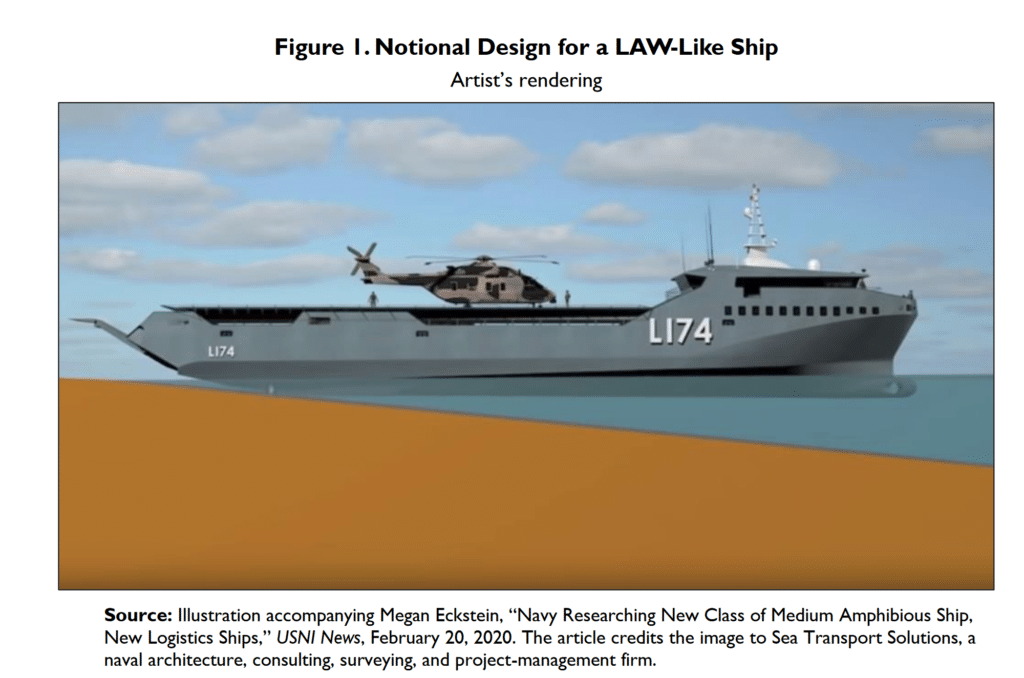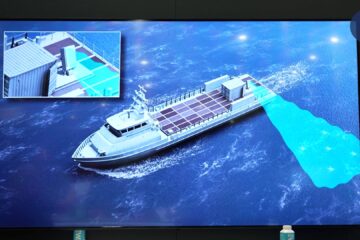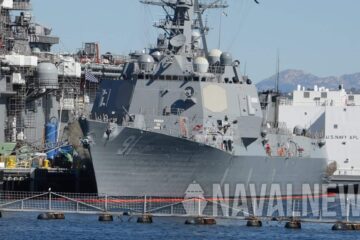The USMC General offered his insights and opinions during SNA 2021
LAWs will patrol the U.S. Navy’s Indo-Pacific Command (INDO-PACOM) area with a platoon of 75 U.S. Marines, an optional helicopter deck, and their associated (armored) vehicles (JLTVs, HMMWVs, ACVs, LAVs, M-ATVs, MRZRs, LVSRs, MTVRs, HIMARS, etc.) that can drive directly onto the beach once the LAW lands on the shoreline.
According to the Congressional Research Service’s (CRS) report, the Light Amphibious Warship (LAW) has the following characteristics:
- “a length of 200 feet to 400 feet;
- a maximum draft of 12 feet;
- a displacement of up to 4,000 tons;
- A ship’s crew of no more than 40 Navy sailors;
- an ability to embark at least 75 Marines;
- 4,000 to 8,000 square feet of cargo area for the Marines’ weapons, equipment, and supplies;
- a stern or bow landing ramp for moving the Marines and their weapons, equipment, and supplies from the ship to shore (and vice versa) across a beach;
- a modest suite of C4I equipment;
- a 25mm or 30mm gun system and .50 caliber machine guns for self-defense;
- a transit speed of at least 14 knots, and preferably 15 knots;
- a minimum unrefueled transit range of 3,500 nautical miles;
- a “Tier 2+” plus level of survivability (i.e., ruggedness for withstanding battle damage)—a level, broadly comparable to that of a smaller U.S. Navy surface combatant (i.e., a corvette or frigate), that would permit the ship to absorb a hit from an enemy weapon and keep the crew safe until they and their equipment and supplies can be transferred to another LAW;
- an ability to operate within fleet groups or deploy independently; and
a 20-year expected service life.”
According to the CRS report, the 28-30 LAWs that the U.S Navy wants will cost around $100 to $150 million each. One or multiple shipyards can build LAWs with the first 10 LAWs procured in FY2022-FY2026 at an estimated price of $150 million each.
General Tracy King, USMC, Comments on the LAW at SNA 2021

At the Surface Navy Association (SNA) 2021 Virtual Symposium held in mid-January, 2021, Major General Tracy King, U.S. Marine Corp (USMC) said:
“[LAW] She remains my Number One Priority. Patterned how we acquired the Constellation [FFG(X) frigate] class. LAW will be a Force Multiplier that provides Fleet and Joint Force Commanders a purpose-built capability for naval forces to maintain a persistent presence to deter adversaries. We’re going to able to stay there. Think of it as a Lilly pad; think of a 21st Century LSM [Landing Ship Medium] from World War 2.”
The LAW fills the gap between the Navy’s large Amphibious warships and landing crafts and will leverage commercial elements as the foundational element. “This is a new capability” the General said. LAW is being designed as an affordable low-signature, feature-able, shore-to-shore vessel with inter-theater endurance capable of being operated independently or in collaboration with other service warships and platforms.
“Think 300 to 400 feet, about 2,000 [or 4,000] tons, long range, long endurance, with a mission bay full of whoop-ass. LAW is not an auxiliary; it’s not a connector; it’s not a forcible-entry platform. It is a combatant that will enable persistent presence and enhance tactical mobility in the pursuit of sea denial,”
Major General Tracy King, U.S. Marine Corp

A journalist asked Major General Tracy King what are the LAW’s performance and endurance expectations, to which General King replied, “Working on that right now with our Industry partners, and if I’m not mistaken, we have 11 [partners]”.
“As a ship, she will have very long endurance, long legs…going to be able to get from Hawaii to [the] first Island Chain, second Island Chain, and kind of be able to stay out there. She’s going to be able to carry lots of excess fuel. She will be able to make water. The Marines will bring their own food; it will probably be the form of trade rations, which we use often. With 8[thousand] to 12,000 sq. foot cargo space, which again is the threshold objective, if we need to go longer than 30 days, we can do that. But you’re hitting on one of the things that make the Light Amphibious Warship unique in that she is a Lilly pad. …But boy, when you hit the beach, it’s time to get off. The LAW, the Marines will be able to live on it, and operate from it, and move around on it, and get back on it because she’s going to be beachable. So, I’m not concerned about the endurance”.
“All eleven of our Industry partners with their indictive designs—we’ve just completed our second Industries studies—met our objectives, which were the higher end of the endurance requirements.”
Riding “LAW Shotgun” with LPD-17s and not the Expeditionary Sea Bases (ESB)

Major General Tracy King, USMC, envisions the Landing Platform Dock-17s (LPD-17) as the ship to “ride shotgun” and escort the LAWs. A journalist asked if the LPD-17 can perform Mine Countermeasures (MCM) and if the MCM Package will be used. General King replied:
“I think that she [LPD-17] can do it, given the fact that she’s the Swiss Army Knife of the fleet. The LPD-17, which I’ve been on most of them…she can do whatever you ask her to do. So, could she do that, yeah, are we looking to do that right now? I think I would defer that to the Fleet Commanders, but I would probably say, `No.’ Could we do [MCM from LPD], yeah, should we do, probably no.”
General King wants to use the Expeditionary Sea Bases (ESBs) instead for MCM and prefers to do MCM from the Littoral Combat Ship (LCS), given the LCS’s capabilities.
“ESBs…it’s a blank palette,” noted Major General King. “I’m not much of a painter, but you can do pretty much whatever you want to. If I’m not mistaken, it’s the second largest landing space in the Fleet. So, it’s got a beautiful [flight deck of] several landing spots, and with some additional modifications, she can theoretically take JSF [F-35B] if you wanted to. MV-22s. Right now, we’re putting habitability pods on them to double the size of the deploy contingent. She can easily handle that. But when you walk around, it’s got a lot of space as Plug-and-play capabilities.”
The ESB Skippers are not at all fearful of mines because, according to the Skippers, the ESB is highly survivable. “Even though we want to get the man out of the minefield, if you’re going to get close to a minefield, it’s probably best to be on an ESB because she can take a hit and keep on ticking.” The U.S. Special Operations Command’s Naval Special Warfare and Marine Special Operations Command are both excited about the ESB’s MCM capabilities and survivability, noted King.
The LPD-17 is seen as too vital and valuable in its Power Projection role as the premiere ship and the intended sheepdog for the LAWs instead of being used for MCM duties, noted General King. “Someone to husband them [the LAWs] and tell them what is the next mission and tie them into the protective umbrella of the Fleet is what I think the LPD-17 will be doing.” For the record, the U.S. Navy is looking at arming the LPD-17 Amphibious Vessels with long-range missiles.
Naval News comments

For purely speculative analysis discussion for this article, the U.S. Navy’s LAW concept seems reasonable and would work for complementing the U.S. Navy’s LPD-17 “Large Amphibs” and the Landing Craft Air Cushion (LCACs) and Sea-to-Shore Connector (SSC) hovercrafts. However, the LAW is lightly armed, having only a single bow 25mm Mk38 MOD 3 or a 30mm autocannon. Hence, the LAW can benefit from additional firepower support such as using a triple to quadruple-combination Remote Weapons Station such as the Leonardo RiWP with guided rocket or missile pods instead of just the autocannon, or adding coaxial weapons to the autocannon, and adding small precision guided missiles mounted in above-deck launchers located on side platforms or on top of the wheelhouse.

Furthermore, the U.S. Navy could design a small open or closed cabin passenger hovercraft for the cargo area. This would benefit the Marines better than using a single RHIB slung over the LAW’s side that is hard to access and egress for missions, requiring the use of a crane to raise and lower, a challenge during inclement weather.
The small hovercraft can launch out of a partially lowered reinforced stern ramp without flooding the cargo vehicle area.
A hovercraft can lift itself from six inches to over seven feet into the air, dependent on size, weight, and the power of its engine(s); therefore, the LAW’s stern ramp just needs to be lowered horizontal, and not dropped into the ocean, for a small hovercraft to enter and exit the cargo area. Dependent on size, such a hovercraft can have versatility in multifunction usage and even combat striking power, and exit first before any Marine ground vehicles roll ashore once the LAW landed. Some small hovercraft examples are presented below that can fit inside the LAW’s cargo area for the length of a Joint Light Tactical Vehicle (JLTV) 4×4 truck or two.
The United Kingdom’s GriffonHoverwork®380TD hovercraft (left) is just 6.8m (22 feet, or the length of one JLTV) long and can transport five (3-4 passengers) and/or 380 kg (837 lbs) in an open-air environment. Such a small hovercraft would complement the RHIB slung over the LAW’s side and perform Search and Rescue, VBSS Inspection, patrols, landings, logistics, liaison, medical evacuation, C4I, and Anti-Air and Anti-Tank/Surface defense if the Marines are properly armed.
The United Kingdom’s GriffonHoverwork®2000TD hovercraft (right) is 12.7m (41 feet, or the length of two JLTVs) long and can transport 12-14 passengers and/or 2,000 kg (4,409 lbs) in a sheltered (armored) cabin. The roof can mount a remote weapons turret such as the CROWS-Javelin or Leonardo RiWP and act as a protector to the LAW and U.S. Marines ashore.
GriffonHoverwork pictures.
The LAWs living spaces are probably too small for a full Mess Hall and Galleys for the Enlisted and the officers. If so, portable hot kitchenette stoves, refrigerators, and freezers, even if on catering carts, should be purchased for better quality of life aboard to serve some form of hot, cold, and fresh foods than just eating trade rations in the form of prepackaged Meals Ready to Eat (MREs) for around thirty days. These small cooking and refrigeration trailers can be placed in the cargo area or used on the helicopter flight deck for better venting and fire prevention, and will help boost morale, fitness, and endurance to those serving aboard. Microwaves and other portable heating units should also be considered for light to moderate cooking of hot meals inside.








